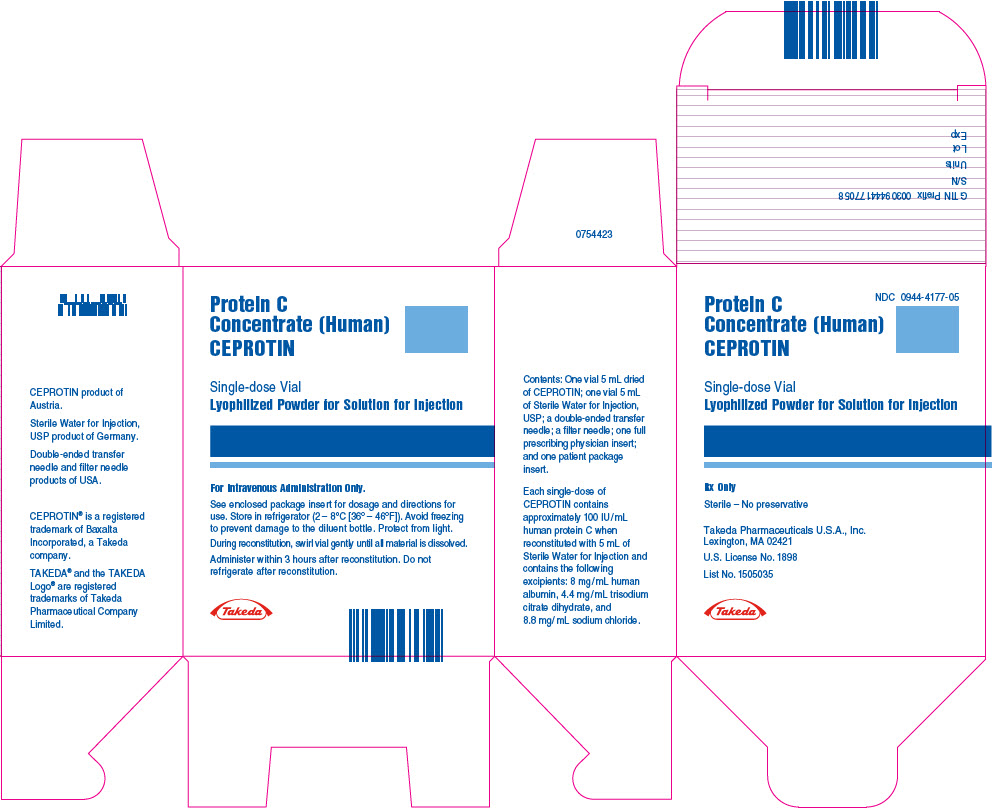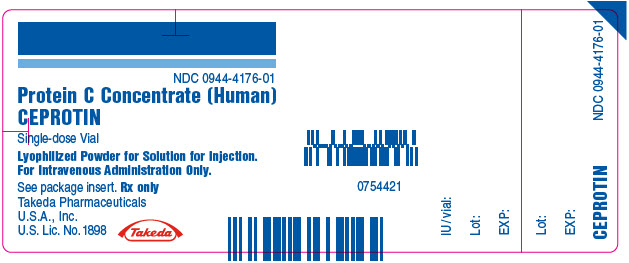Ceprotin
Generic name: Protein C Concentrate (Human)
Drug class: Miscellaneous coagulation modifiers
Medically reviewed by A Ras MD.
What is Ceprotin?
Ceprotin is a prescription medicine that is used to treat protein C deficiency.
Description
CEPROTIN [Protein C Concentrate (Human)] is manufactured from human plasma purified by a combination of filtration and chromatographic procedures, including a column of immobilized mouse monoclonal antibodies on gel beads .
The manufacturing process for CEPROTIN includes processing steps designed to reduce the risk of viral transmission. The capacity of the manufacturing process to remove and/or inactivate enveloped and non-enveloped viruses has been validated by laboratory spiking studies on a scaled down process model, using the following enveloped and non-enveloped viruses: Human Immunodeficiency Virus Type 1 (HIV-1), Bovine Viral Diarrhea Virus (BVDV ), Tick-Borne Encephalitis Virus (TBEV), Pseudorabies Virus (PRV), Hepatitis A Virus (HAV) and Mice Minute Virus (MMV). Virus reduction steps consist of detergent treatment (Polysorbate 80, P80), heat inactivation (Vapor Heating) and immunoaffinity chromatography (IAX).
Virus clearance studies for CEPROTIN have demonstrated that the process provides for a robust overall virus clearance capacity. A summary of log10 virus reduction factors per virus and manufacturing step is presented in Table 2.
| Manufacturing Step | HIV-1 | HCV Model Viruses | PRV | HAV | MMV | |
|---|---|---|---|---|---|---|
| BVDV | TBEV | |||||
| Abbreviations: IEX, Ion Exchange Chromatography; IAX, Immunoaffinity Chromatography; HIV-1, Human Immunodeficiency Virus Type I; TBEV, Tick-Borne Encephalitis Virus (model for hepatitis C virus [HCV]); BVDV, Bovine Viral Diarrhea Virus (model virus for HCV and other small, enveloped RNA viruses); PRV, Pseudorabies Virus (model virus for enveloped DNA viruses, e.g. HBV, Hepatitis B Virus); HAV, Hepatitis A Virus; MMV, Mice Minute Virus (model for Human Parvovirus B19 and for non enveloped viruses); n.d., not done. | ||||||
|
||||||
| P80 Treatment | >5.1 | >4.7 | n.d. | 2.5* | >3.8* | 1.4* |
| IAX | 3.9 | 2.9 | 3.8 | 4.0 | 0.9 | 3.5 |
| Vapor Heating | 4.6 | >5.9 | n.d. | 5.9 | >4.2 | 1.2 |
Mechanism of Action
Protein C is the precursor of a vitamin K-dependent anticoagulant glycoprotein (serine protease) that is synthesized in the liver . It is converted by the thrombin/thrombomodulin-complex on the endothelial cell surface to activated Protein C (APC). APC is a serine protease with potent anticoagulant effects, especially in the presence of its cofactor protein S. APC exerts its effect by the inactivation of the activated forms of factors V and VIII, which leads to a decrease in thrombin formation. APC has also been shown to have profibrinolytic effects.
The Protein C pathway provides a natural mechanism for control of the coagulation system and prevention of excessive procoagulant responses to activating stimuli. A complete absence of protein C is not compatible with life. A severe deficiency of this anticoagulant protein causes a defect in the control mechanism and leads to unchecked coagulation activation, resulting in thrombin generation and intravascular clot formation with thrombosis.
Before taking Ceprotin, tell your doctor:
- If you are allergic to heparin or mouse proteins, talk with the doctor.
- If you are allergic to Ceprotin; any part of this medicine; or any other drugs, foods, or substances. Tell your doctor about the allergy and what signs you had.
This medicine may interact with other drugs or health problems.
Tell your doctor and pharmacist about all of your drugs (prescription or OTC, natural products, vitamins) and health problems. You must check to make sure that it is safe for you to take Ceprotin with all of your drugs and health problems. Do not start, stop, or change the dose of any drug without checking with your doctor.
What are some things I need to know or do while I take Ceprotin?
- Tell all of your health care providers that you take Ceprotin. This includes your doctors, nurses, pharmacists, and dentists.
- Have blood work checked as you have been told by the doctor. Talk with the doctor.
- If you are on a low-sodium or sodium-free diet, talk with your doctor. Some of these products have sodium.
- This medicine has small amounts of heparin in it. This may lead to a very bad blood problem called heparin-induced thrombocytopenia (HIT). If this happens, bleeding could happen more easily. Talk with the doctor.
- This medicine is made from human plasma (part of the blood) and may have viruses that may cause disease. This medicine is screened, tested, and treated to lower the chance that it carries an infection. Talk with the doctor.
- Tell your doctor if you are pregnant, plan on getting pregnant, or are breast-feeding. You will need to talk about the benefits and risks to you and the baby.
How is Ceprotin best taken?
Use Ceprotin as ordered by your doctor. Read all information given to you. Follow all instructions closely.
- It is given into a vein for a period of time.
- If you will be giving yourself the shot, your doctor or nurse will teach you how to give the shot.
- Wash your hands before and after use.
- This medicine needs to be mixed before use. Follow how to mix as you were told by the doctor.
- Let Ceprotin come to room temperature before mixing. Do not heat Ceprotin.
- Do not shake the solution.
- Use within 3 hours of making.
- Do not use if the solution is cloudy, leaking, or has particles.
- This medicine is colorless to a faint yellow. Do not use if the solution changes color.
- Each vial is for one use only. Throw away any part not used after the dose is given.
- Throw away needles in a needle/sharp disposal box. Do not reuse needles or other items. When the box is full, follow all local rules for getting rid of it. Talk with a doctor or pharmacist if you have any questions.
What do I do if I miss a dose?
- Call your doctor to find out what to do.
What are the side effects of Ceprotin that I need to call my doctor about immediately?
WARNING/CAUTION: Even though it may be rare, some people may have very bad and sometimes deadly side effects when taking a drug. Tell your doctor or get medical help right away if you have any of the following signs or symptoms that may be related to a very bad side effect:
- Signs of an allergic reaction, like rash; hives; itching; red, swollen, blistered, or peeling skin with or without fever; wheezing; tightness in the chest or throat; trouble breathing, swallowing, or talking; unusual hoarseness; or swelling of the mouth, face, lips, tongue, or throat.
- Signs of bleeding like throwing up or coughing up blood; vomit that looks like coffee grounds; blood in the urine; black, red, or tarry stools; bleeding from the gums; abnormal vaginal bleeding; bruises without a cause or that get bigger; or bleeding you cannot stop.
- Dizziness or passing out.
- Shortness of breath.
What are some other side effects of Ceprotin?
All drugs may cause side effects. However, many people have no side effects or only have minor side effects. Call your doctor or get medical help if you have any side effects that bother you or do not go away.
These are not all of the side effects that may occur. If you have questions about side effects, call your doctor. Call your doctor for medical advice about side effects.
You may report side effects to the FDA at 1-800-332-1088. You may also report side effects at https://www.fda.gov/medwatch.
If overdose is suspected:
If you think there has been an overdose, call your poison control center or get medical care right away. Be ready to tell or show what was taken, how much, and when it happened.
How do I store and/or throw out Ceprotin?
- Store in a refrigerator. Do not freeze.
- Store in the original container to protect from light.
- Keep all drugs in a safe place. Keep all drugs out of the reach of children and pets.
- Throw away unused or expired drugs. Do not flush down a toilet or pour down a drain unless you are told to do so. Check with your pharmacist if you have questions about the best way to throw out drugs. There may be drug take-back programs in your area.
Label
PRINCIPAL DISPLAY PANEL – KIT CARTON – NDC 0944-4177-05
- Protein C
Concentrate (Human)
CEPROTIN - Single-dose Vial
- Lyophilized Powder for Solution for Injection
- Shire
- For Intravenous Administration Only.
- See enclosed package insert for dosage and directions for use.
Store in refrigerator (2 – 8°C [36° – 46°F]).
Avoid freezing to prevent damage to the diluent bottle.
Protect from light. - During reconstitution, swirl vial gently until all material is
dissolved. - Administer within 3 hours after reconstitution.
Do not refrigerate after reconstitution.

PRINCIPAL DISPLAY PANEL – 5 ML VIAL LABEL – NDC 0944-4176-01
- Shire
- NDC 0944-4176-01
- Protein C Concentrate (Human)
CEPROTIN - Single-dose Vial
- Lyophilized Powder for Solution for Injection.
For Intravenous Administration Only. - See package insert. Rx only.

SRC: NLM .
